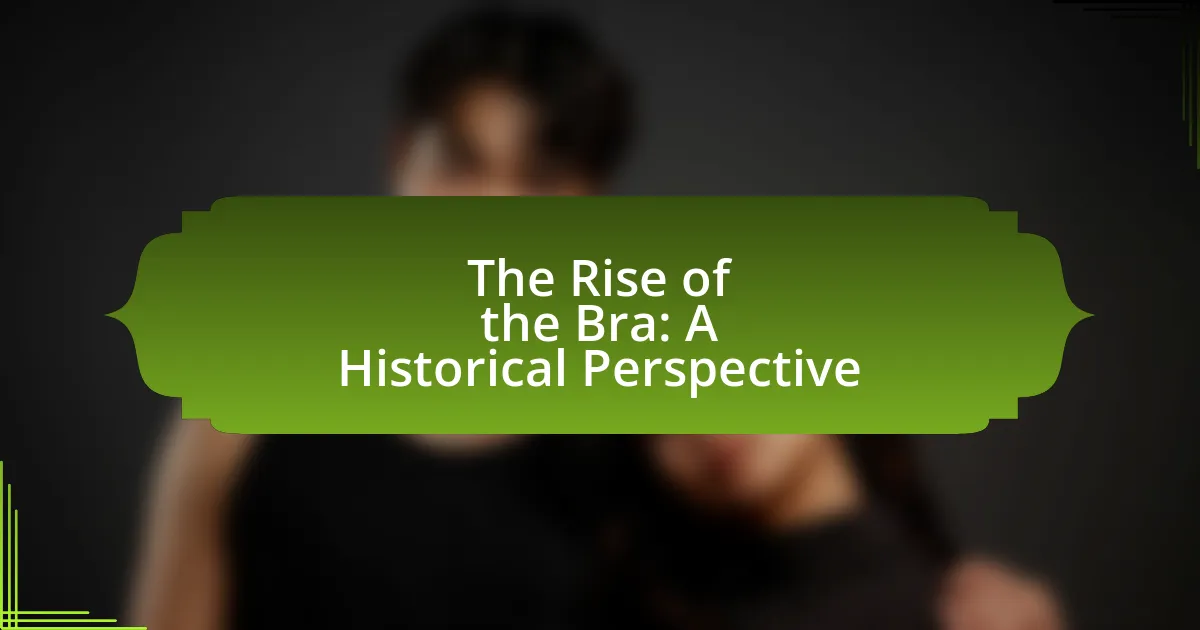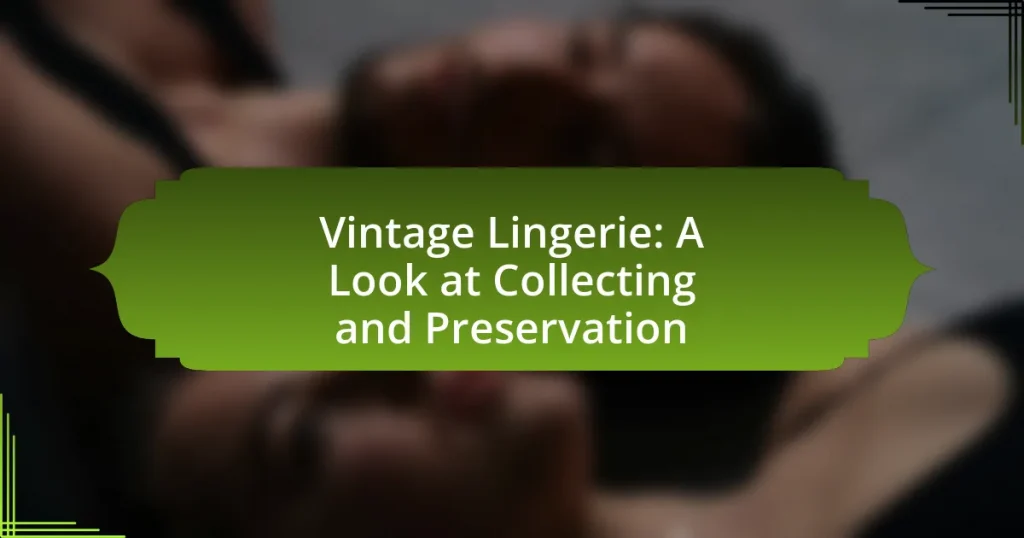The main entity of the article is the bra, which is explored through its historical significance and evolution as a symbol of women’s liberation and changing societal norms. The article outlines the transition of women’s undergarments from restrictive corsets to more functional bras, highlighting key events such as the women’s suffrage movement and the feminist protests of the 1960s and 1970s that shaped public perception. It discusses the impact of fashion trends on bra design, the various types of bras available today, and the technological advancements that have influenced their development. Additionally, the article addresses common misconceptions about bras and provides guidance on selecting the right bra for individual needs, emphasizing the importance of comfort and support.

What is the historical significance of the bra?
The historical significance of the bra lies in its evolution as a symbol of women’s liberation and changing societal norms regarding femininity and body image. Initially, in the early 20th century, the bra emerged as a functional garment designed to replace restrictive corsets, reflecting a shift towards comfort and practicality in women’s fashion. The 1913 “bra burning” protests during the Women’s Liberation Movement further solidified the bra’s role as a political statement against patriarchy and traditional gender roles. This garment has since evolved into a multifaceted symbol, representing both empowerment and the ongoing dialogue about women’s rights, body autonomy, and societal expectations.
How did the concept of women’s undergarments evolve over time?
The concept of women’s undergarments evolved significantly from the early 19th century to the present day, transitioning from restrictive garments to more functional and diverse options. Initially, women wore corsets, which were designed to shape the body and create an hourglass figure, often leading to health issues due to their tightness. By the late 19th century, the introduction of the brassiere marked a shift towards more comfort and practicality, as it provided support without the constriction of corsets.
In the early 20th century, the bra became more widely accepted, with various styles emerging to cater to different body types and fashion trends. The 1960s and 1970s saw the rise of the feminist movement, which challenged traditional notions of femininity and led to the popularity of bralessness, promoting body positivity and comfort.
By the late 20th and early 21st centuries, advancements in fabric technology and design led to a vast array of undergarment options, including sports bras, push-up bras, and wireless designs, reflecting a focus on both functionality and personal expression. This evolution illustrates how societal changes, fashion trends, and technological advancements have shaped women’s undergarments over time.
What were the earliest forms of breast support in history?
The earliest forms of breast support in history included garments such as the bandeau and corset. The bandeau, used in ancient civilizations like Greece and Rome, was a simple cloth wrap that provided minimal support. Corsets emerged in the 16th century, designed to shape the torso and support the breasts more effectively, often made from materials like whalebone and steel. Historical records indicate that these garments were not only functional but also reflected societal standards of beauty and femininity during their respective eras.
How did cultural attitudes towards women’s bodies influence undergarment design?
Cultural attitudes towards women’s bodies significantly influenced undergarment design by dictating the ideals of femininity and modesty throughout history. For instance, in the Victorian era, the emphasis on an hourglass figure led to the creation of corsets that tightly constricted the waist, reflecting societal values that equated a small waist with beauty and virtue. This design choice was reinforced by the prevailing belief that women’s bodies should be both alluring and restrained, which shaped the functionality and aesthetics of undergarments. Additionally, the feminist movements of the 20th century challenged these restrictive designs, leading to the introduction of more comfortable and liberating styles, such as bras that prioritized support over shape. This evolution in undergarment design illustrates how shifting cultural perceptions of women’s bodies directly impacted the materials, shapes, and purposes of undergarments, aligning them with contemporary ideals of body positivity and freedom.
What role did fashion play in the development of the bra?
Fashion played a crucial role in the development of the bra by influencing societal norms regarding women’s bodies and undergarments. In the early 20th century, as women’s fashion shifted towards more form-fitting clothing, the need for supportive undergarments became apparent. The introduction of the modern bra in 1914, designed by Mary Phelps Jacob, was a direct response to the restrictive corsets that dominated women’s fashion at the time. This innovation allowed for greater comfort and freedom of movement, aligning with the evolving fashion trends that emphasized a more natural silhouette. The bra’s design continued to evolve throughout the decades, reflecting changes in fashion, such as the rise of the flapper style in the 1920s, which favored a boyish figure, and later, the push-up bras of the 1950s that catered to the hourglass ideal. Thus, fashion not only shaped the design and functionality of the bra but also played a significant role in redefining women’s body image and societal expectations.
How did societal norms shape the styles of bras throughout different eras?
Societal norms significantly influenced the styles of bras throughout different eras by dictating ideals of femininity, modesty, and body shape. In the early 20th century, the introduction of the modern bra coincided with the women’s suffrage movement, reflecting a shift towards more practical and liberating undergarments that supported women’s active roles in society. The 1920s flapper era embraced a boyish silhouette, leading to the popularity of the bandeau style, which flattened the bust to align with the androgynous fashion of the time.
During the 1950s, the idealized hourglass figure emerged, prompting the design of bras with more structure, such as the bullet bra, to enhance curves and conform to societal expectations of femininity. The feminist movements of the 1960s and 1970s challenged traditional beauty standards, resulting in the rise of bralessness and more comfortable, less restrictive styles like the bralette.
In contemporary society, the focus has shifted towards body positivity and inclusivity, leading to diverse styles that cater to various body types and personal preferences, reflecting a broader acceptance of individual expression. This evolution illustrates how societal norms have continuously shaped bra styles, adapting to cultural shifts and changing perceptions of women’s roles and bodies.
What were the key fashion movements that impacted bra design?
Key fashion movements that impacted bra design include the Victorian era’s emphasis on corsetry, the flapper movement’s liberation in the 1920s, and the feminist movements of the 1960s and 1970s. The Victorian era prioritized structured undergarments, leading to the creation of bras that mimicked corsets, providing support while shaping the body. The 1920s flapper movement introduced a more relaxed silhouette, prompting the design of bras that offered less constriction and more comfort. The feminist movements of the 1960s and 1970s challenged traditional notions of femininity, resulting in the popularization of bralessness and the introduction of more functional, comfortable designs that emphasized personal choice over societal expectations. These movements collectively shaped the evolution of bra design, reflecting changing attitudes towards women’s bodies and fashion.
How did the bra become a symbol of women’s liberation?
The bra became a symbol of women’s liberation primarily through its association with the feminist movements of the 1960s and 1970s. During this period, women began to challenge traditional gender roles and societal expectations, viewing the bra as a restrictive garment that represented oppression. The 1968 Miss America protest, where women famously burned bras, highlighted this sentiment and galvanized public attention, framing the bra as a representation of patriarchal control over women’s bodies. This act of defiance was emblematic of a broader struggle for equality and autonomy, making the bra a powerful icon of women’s liberation.
What historical events contributed to the rise of the modern bra?
The rise of the modern bra was significantly influenced by the women’s suffrage movement and World War I. The women’s suffrage movement in the early 20th century challenged traditional gender roles, leading to increased demand for practical and comfortable undergarments that allowed women greater freedom of movement. During World War I, women entered the workforce in unprecedented numbers, necessitating a shift from restrictive corsets to more functional designs. This period saw the introduction of the bra as a supportive garment, with the first patent for a modern bra issued to Mary Phelps Jacob in 1914. The combination of social change and wartime necessity catalyzed the transition from corsets to bras, marking a pivotal moment in women’s fashion and undergarment design.
How did the suffragette movement influence women’s undergarments?
The suffragette movement significantly influenced women’s undergarments by promoting a shift towards more practical and less restrictive clothing, including the early adoption of the bra. As women fought for their rights and greater freedom, they began to reject the corsets that symbolized oppression and physical constraint. This movement coincided with the introduction of the modern bra in the early 20th century, which offered support without the discomfort of traditional corsetry. The suffragettes’ emphasis on physical freedom and mobility directly contributed to the acceptance and popularity of bras, as they represented a new era of women’s liberation and self-expression.
What impact did World War II have on bra production and design?
World War II significantly transformed bra production and design by necessitating the use of more practical materials and styles to accommodate women’s roles in the workforce. During the war, many women entered factories and other jobs traditionally held by men, leading to a demand for functional and supportive undergarments that could withstand rigorous activities. As a result, manufacturers shifted from delicate fabrics to sturdier materials like cotton and nylon, which were more durable and easier to produce in large quantities. Additionally, the design of bras evolved to prioritize comfort and utility over aesthetics, reflecting the changing societal roles of women during this period. This shift laid the groundwork for modern bra styles, emphasizing both functionality and support, which became standard in post-war fashion.
Why did the feminist movement embrace or reject the bra?
The feminist movement largely rejected the bra as a symbol of oppression and a tool of the patriarchy. Many feminists viewed the bra as an object that constrained women’s bodies and reinforced traditional gender roles. In the 1960s, protests against bras, such as the famous “bra-burning” demonstrations, highlighted the desire for women’s liberation from societal expectations regarding femininity and appearance. This rejection was rooted in the belief that women should have the freedom to choose how they present themselves without being bound by restrictive garments that symbolize male control.
What arguments were made for and against wearing bras during the feminist movement?
Arguments for wearing bras during the feminist movement included the belief that bras could empower women by providing support and enhancing their appearance, thus allowing them to feel more confident in professional and social settings. Proponents argued that wearing a bra was a personal choice that could reflect a woman’s femininity and self-expression.
Conversely, arguments against wearing bras centered on the idea that bras were a symbol of patriarchal oppression, restricting women’s bodies and reinforcing societal expectations of femininity. Critics contended that rejecting bras was a form of liberation, promoting body positivity and comfort over conforming to traditional beauty standards. This perspective gained traction during the 1960s and 1970s, as many feminists advocated for women’s autonomy over their bodies and choices.
How did the perception of bras change in the 1960s and 1970s?
In the 1960s and 1970s, the perception of bras shifted from being seen as essential undergarments for modesty and support to symbols of female liberation and empowerment. This change was influenced by the feminist movement, which challenged traditional gender roles and advocated for women’s rights, including the rejection of restrictive clothing. The 1968 Miss America protest, where bras were symbolically discarded, highlighted this shift, as it represented a broader rejection of societal expectations regarding women’s bodies. Additionally, the introduction of more comfortable and diverse bra styles during this period allowed women to embrace personal choice over conformity, further altering the cultural significance of bras.

What are the different types of bras and their purposes?
There are several types of bras, each designed for specific purposes. The most common types include:
-
T-shirt Bra: This bra features seamless cups and is designed to be invisible under clothing, providing a smooth silhouette.
-
Push-up Bra: This style enhances cleavage by using padding to lift the breasts, making it ideal for low-cut tops.
-
Sports Bra: Specifically designed for physical activity, sports bras provide support and minimize movement during exercise.
-
Bralette: A lightweight, often unpadded bra that offers minimal support, bralettes are typically worn for comfort and style rather than function.
-
Underwire Bra: This type includes a wire under the cups for added support and lift, suitable for everyday wear.
-
Strapless Bra: Designed to stay in place without shoulder straps, strapless bras are ideal for off-the-shoulder or strapless outfits.
-
Nursing Bra: This bra features clasps or panels that allow for easy breastfeeding access, catering to nursing mothers.
-
Maternity Bra: Designed for comfort and support during pregnancy, maternity bras accommodate changes in breast size.
Each type of bra serves a distinct function, catering to different clothing styles, activities, and personal preferences.
What are the main categories of bras available today?
The main categories of bras available today include underwire bras, wireless bras, sports bras, push-up bras, bralettes, and maternity bras. Underwire bras provide support and shape through a wire sewn into the fabric, while wireless bras offer comfort without the wire, catering to those seeking a more relaxed fit. Sports bras are designed for physical activity, providing support and minimizing movement during exercise. Push-up bras enhance cleavage by using padding, whereas bralettes are typically unstructured and focus on comfort and style. Maternity bras are specifically designed to accommodate changes in a woman’s body during pregnancy and breastfeeding. These categories reflect the diverse needs and preferences of consumers in the lingerie market today.
How do different bra styles cater to various body types and needs?
Different bra styles cater to various body types and needs by providing tailored support, shape, and comfort. For instance, full-coverage bras are designed for larger busts, offering more support and minimizing bounce, while push-up bras enhance cleavage and are suitable for smaller busts, creating a fuller appearance. Sports bras are engineered to reduce movement during physical activity, making them essential for active individuals, regardless of size. Additionally, bralettes provide a more relaxed fit for those seeking comfort over structure, appealing to a range of body types. Each style addresses specific anatomical needs and preferences, ensuring that women can find options that suit their unique shapes and lifestyles.
What innovations have been made in bra technology and materials?
Innovations in bra technology and materials include the development of moisture-wicking fabrics, seamless construction techniques, and adjustable components for enhanced comfort and fit. Moisture-wicking fabrics, such as those made from polyester blends, help to keep the skin dry and comfortable during physical activity. Seamless construction techniques reduce chafing and irritation by eliminating bulky seams, while adjustable components like straps and bands allow for a customizable fit, accommodating various body shapes and sizes. These advancements have been driven by consumer demand for both functionality and comfort, leading to a significant evolution in bra design and performance.
How can one choose the right bra for their needs?
To choose the right bra for individual needs, one should first determine their correct size by measuring the band and cup size accurately. Proper sizing is crucial, as studies indicate that approximately 80% of women wear the wrong bra size, leading to discomfort and inadequate support. Next, consider the intended use, such as everyday wear, sports, or special occasions, as different styles provide varying levels of support and comfort. For instance, sports bras are designed to minimize movement during physical activity, while underwire bras offer more structure for everyday use. Additionally, fabric choice is important; breathable materials like cotton are ideal for daily wear, while moisture-wicking fabrics are better for athletic activities. Finally, trying on multiple styles and brands is essential, as fit and comfort can vary significantly between manufacturers.
What factors should be considered when selecting a bra size?
When selecting a bra size, factors such as band size, cup size, breast shape, and personal comfort should be considered. Band size is determined by measuring the circumference under the bust, while cup size is based on the difference between the bust measurement and the band measurement. Breast shape affects how a bra fits and supports, as different styles cater to various shapes. Comfort is subjective but crucial, as a well-fitting bra should provide support without causing discomfort. Accurate sizing can significantly impact overall fit and support, with studies indicating that up to 80% of women wear the wrong bra size, highlighting the importance of proper measurement and fit.
How can comfort and support be balanced in bra selection?
To balance comfort and support in bra selection, it is essential to choose the right size and style that accommodates individual body shapes and preferences. A well-fitted bra provides adequate support through features like underwire, wide straps, and a supportive band, while materials such as soft cotton or breathable lace enhance comfort. Research indicates that approximately 80% of women wear the wrong bra size, which can lead to discomfort and inadequate support, highlighting the importance of proper fitting. Additionally, selecting bras designed for specific activities, such as sports bras for physical activity, can further optimize both comfort and support.
What are some common misconceptions about bras?
Common misconceptions about bras include the belief that they prevent breast sagging, that all women need to wear them for support, and that wearing a bra is universally uncomfortable. Research indicates that while bras can provide support, they do not significantly affect breast sagging, which is primarily influenced by factors like genetics and aging. Additionally, not all women require a bra for comfort or support; many choose to go braless based on personal preference and body type. Lastly, discomfort associated with bras often stems from improper fit rather than the garment itself, as studies show that a well-fitted bra can enhance comfort.
How do myths about bras affect women’s choices and body image?
Myths about bras significantly influence women’s choices and body image by perpetuating unrealistic standards and expectations. These myths, such as the belief that wearing a bra is essential for breast health or that certain styles enhance attractiveness, can lead women to feel pressured to conform to societal norms. Research indicates that 85% of women wear the wrong bra size, often due to misinformation about sizing and fit, which can negatively impact comfort and self-esteem. Additionally, studies show that women who internalize these myths may experience body dissatisfaction, as they compare themselves to idealized images often promoted in media. This cycle of myth and perception can ultimately shape women’s purchasing decisions and their overall relationship with their bodies.
What evidence exists to debunk common bra-related myths?
Evidence debunking common bra-related myths includes scientific studies and expert opinions that challenge misconceptions about bras. For instance, the myth that wearing a bra prevents sagging is contradicted by research published in the British Journal of Sports Medicine, which indicates that breast support does not influence the natural aging process of breast tissue. Additionally, the belief that bras cause breast cancer has been refuted by the American Cancer Society, which states there is no credible evidence linking bra use to an increased risk of cancer. These findings highlight that many widely held beliefs about bras lack scientific support.
What tips can help women find the perfect bra?
To find the perfect bra, women should focus on accurate measurements, proper fit, and personal comfort. Accurate measurements involve determining both band size and cup size, which can be done using a measuring tape or by consulting a professional fitter. A proper fit means the band should sit level around the body, and the cups should fully encase the breasts without overflow or gaps. Personal comfort is crucial; women should try on various styles and materials to find what feels best for their body type. Studies indicate that approximately 80% of women wear the wrong bra size, highlighting the importance of these tips for achieving the right fit and comfort.



